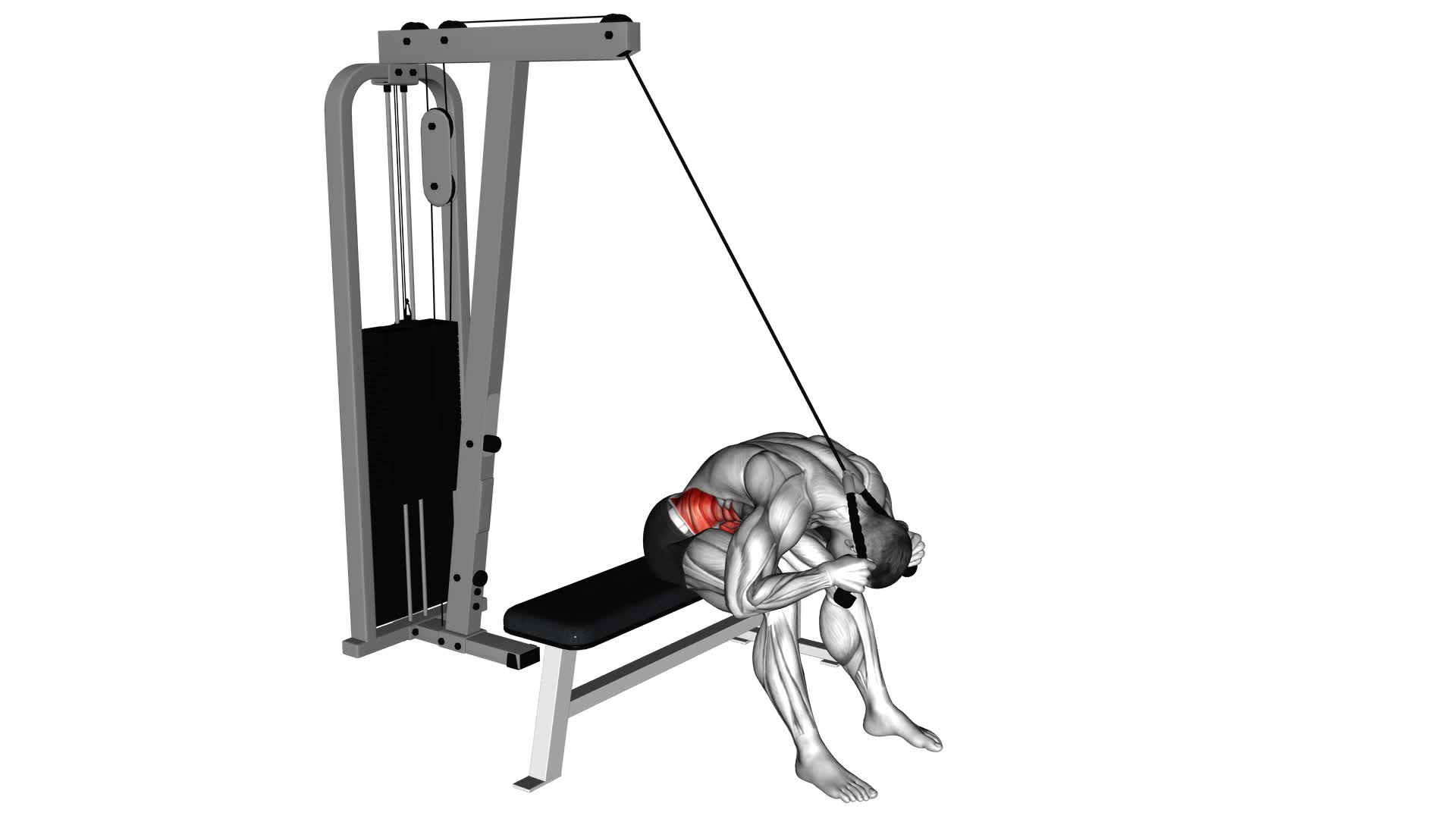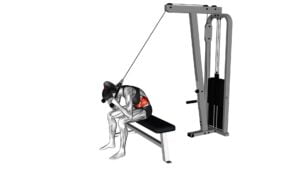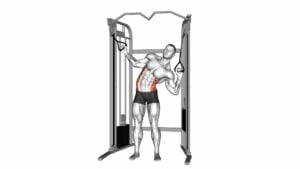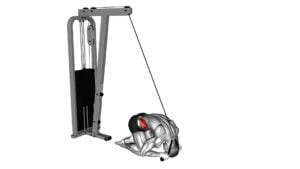Cable Seated Crunch – Video Exercise Guide & Tips

Looking to strengthen your core and tone your abs? The cable seated crunch is an effective exercise that targets those muscles directly.
Watch This Exercise Video
In this video exercise guide, we'll show you the proper form and technique, as well as common mistakes to avoid.
Plus, we'll provide variations and modifications to challenge yourself even further.
Get ready to maximize your workout and achieve those desired results. Let's get started!
Key Takeaways
- The Cable Seated Crunch targets abdominal muscles and activates core muscles for improved stability and balance.
- It can enhance overall athletic performance by improving power generation and energy transfer.
- Alternative equipment such as resistance bands or dumbbells can be used if a cable machine is not available.
- Proper form and technique, including engaging core muscles and maintaining a neutral spine, are important to maximize the benefits of the exercise.
Benefits of the Cable Seated Crunch
You'll discover the advantages of incorporating the Cable Seated Crunch into your workout routine. This exercise offers numerous benefits, especially when it comes to core engagement. The Cable Seated Crunch targets your abdominal muscles, specifically the rectus abdominis, obliques, and transverse abdominis.
By sitting on a bench and pulling the cable towards your body, you activate your core muscles to stabilize your spine and maintain proper form throughout the movement. This exercise helps strengthen your core, leading to improved stability and balance in your everyday activities.
Additionally, the Cable Seated Crunch can also help with enhancing your overall athletic performance. A strong core is essential for generating power and transferring energy between your upper and lower body. By incorporating this exercise into your routine, you can enhance your athletic performance in various sports and activities.
Now that you understand the benefits of the Cable Seated Crunch, let's move on to the equipment needed for this exercise.
Equipment Needed for the Exercise
To perform the Cable Seated Crunch, you'll need some specific equipment. The necessary equipment includes:
- A cable machine with a high pulley
- A seat or bench
- A cable attachment such as a rope or handle
If you don't have access to a cable machine, there are alternative exercises you can do to target the same muscle groups.
Necessary Equipment for Exercise
To perform the cable seated crunch exercise, you'll need specific equipment. Here are the three items you'll need:
- Cable Machine: This exercise requires a cable machine with an adjustable weight stack. The cable machine provides the resistance needed to target your core muscles effectively.
- Cable Attachment: You'll need a cable attachment called a rope handle. This attachment allows you to grasp the cables securely and perform the crunching motion.
- Bench or Seat: To perform the exercise correctly, you'll need a stable bench or seat. Sit on the bench with your feet firmly planted on the ground and your knees bent at a 90-degree angle.
Having the right equipment is essential to perform the cable seated crunch effectively. Remember to always consult a fitness professional before attempting any new exercise to ensure proper form and technique.
Equipment Alternatives for Exercise
For the cable seated crunch exercise, a cable machine, a cable attachment called a rope handle, and a stable bench or seat are necessary equipment.
However, if you don't have access to a cable machine, there are alternative equipment options you can use to modify the exercise.
One option is to use resistance bands instead of the cable machine. Secure the band to an anchor point and hold the handles in your hands as you perform the seated crunch motion.
Another alternative is to use dumbbells or weighted plates. Hold the weights in your hands and perform the crunch motion while seated on a stable bench or seat.
These equipment alternatives allow you to still target your abdominal muscles effectively, even without a cable machine.
Proper Form and Technique
To perform the cable seated crunch with proper form and technique, it's crucial to engage your core muscles effectively. This exercise targets your abdominal muscles, and by focusing on contracting and tightening your core, you maximize the benefits.
Additionally, it's important to avoid common form mistakes such as using momentum or pulling on the cable with your arms. By maintaining control and proper alignment, you can ensure that you're getting the most out of this exercise.
Engaging Core Muscles Effectively
You can effectively engage your core muscles by focusing on proper form and technique. Here are three key tips to help you maximize core activation and stability during your cable seated crunch:
- Maintain a neutral spine: Keep your back straight and avoid arching or rounding your spine. This helps to engage your deep core muscles and prevents excessive strain on your lower back.
- Engage your abdominals: Before performing the exercise, consciously contract your abdominal muscles. This activation will help stabilize your core and enhance the effectiveness of the crunch.
- Control the movement: Slowly and deliberately perform the cable seated crunch, focusing on engaging your core muscles throughout the entire range of motion. Avoid using momentum or relying solely on your hip flexors.
By implementing these techniques, you can ensure that you're effectively engaging your core muscles during the cable seated crunch, setting yourself up for a successful and safe workout.
Now, let's move on to preventing common form mistakes.
Preventing Common Form Mistakes
Avoid common form mistakes when performing the cable seated crunch by maintaining proper form and technique. By doing so, you can prevent injuries and maximize the benefits of this exercise. Proper form ensures that you engage the targeted muscles effectively and minimize strain on other parts of your body.
When performing the cable seated crunch, keep your back straight and your core engaged throughout the movement. Avoid rounding your back or using momentum to lift the weight. Instead, focus on using your abdominal muscles to initiate the crunching motion.
By maintaining proper form and technique, you can safely and effectively work your core muscles.
Now, let's discuss some common mistakes to avoid when performing the cable seated crunch.
Common Mistakes to Avoid
One common mistake to be mindful of when performing the cable seated crunch is using excessive weight. It can be tempting to load up the weight stack and go for a heavy resistance, thinking that it will give you better results. However, using too much weight can actually compromise your form and put unnecessary strain on your neck and lower back.
To ensure that you're performing the cable seated crunch correctly and avoiding these common mistakes, here are three important tips to keep in mind:
- Focus on the contraction: The goal of the cable seated crunch is to engage your abdominal muscles and create tension in your core. Instead of relying on momentum or pulling with your arms, concentrate on using your abs to initiate the movement. This will help you maintain proper form and maximize the effectiveness of the exercise.
- Control the movement: Avoid rushing through the exercise and instead, focus on controlling the motion. Slowly crunch forward, feeling the squeeze in your abs, and then slowly return to the starting position. This controlled pace will prevent any jerky movements and help you maintain stability throughout the exercise.
- Keep your neck relaxed: It's common to strain your neck when performing the cable seated crunch, especially if you're using too much weight. To avoid this, keep your neck relaxed and in a neutral position throughout the movement. Avoid pulling on your neck with your hands and instead, focus on using your abs to do the work.
Variations and Modifications
To add variety to your cable seated crunch routine, consider incorporating different variations and modifications. By doing so, you can target your abdominal muscles from different angles and increase the intensity of your workout.
One option is to change the position of your hands during the exercise. Instead of placing them behind your head, try crossing them over your chest or extending them straight out in front of you. This simple adjustment can provide a different challenge to your core muscles.
Another way to modify the cable seated crunch is by adjusting the weight. Start with a lighter weight and gradually increase it as you become stronger and more comfortable with the exercise. This will allow you to gradually progress and continue challenging your muscles.
For those looking for advanced modifications, you can try adding resistance bands to your cable seated crunch routine. Attach the bands to the cable machine and then loop them around your shoulders or under your feet. This will add an extra level of resistance and increase the difficulty of the exercise.
Remember, it's important to listen to your body and choose variations and modifications that suit your fitness level. Always maintain proper form and avoid any exercises that cause pain or discomfort.
With these different intensity and advanced modifications, you can keep your cable seated crunch routine challenging and effective.
Tips for Maximizing Your Workout
To get the most out of your workout, try incorporating these tips for maximizing your cable seated crunch routine:
- Maintain proper form: It's crucial to maintain proper form throughout the exercise to maximize results and minimize the risk of injury. Keep your back straight, shoulders relaxed, and engage your core muscles as you perform the cable seated crunch. Avoid using momentum or relying solely on your arms to pull the cables.
- Increase resistance gradually: As your strength improves, gradually increase the resistance on the cable machine. This will challenge your muscles and help you achieve better results. However, make sure not to overload the weight and compromise your form.
- Focus on controlled movements: Instead of rushing through the exercise, focus on performing each repetition with controlled and deliberate movements. This will engage your abdominal muscles more effectively, leading to better workout efficiency and results.
By following these tips, you can maximize the effectiveness of your cable seated crunch routine and achieve your fitness goals more efficiently.
Remember to always listen to your body and adjust the workout intensity according to your fitness level.
Frequently Asked Questions
Can the Cable Seated Crunch Help Me Lose Belly Fat?
The cable seated crunch is effective for strengthening your abdominal muscles. It may not directly help you lose belly fat. However, incorporating the cable seated crunch into a comprehensive workout routine that includes cardio and a balanced diet can contribute to overall weight loss.
How Many Sets and Repetitions Should I Do for the Cable Seated Crunch?
To get the most out of the cable seated crunch, it's important to know how many sets and repetitions to do. The number of sets and reps will depend on your fitness level and goals.
Generally, it's recommended to start with 2-3 sets of 12-15 repetitions. This exercise targets your abdominal muscles, helping to strengthen and tone them.
Remember to maintain proper form by keeping your back straight and engaging your core throughout the movement.
Is It Safe to Perform the Cable Seated Crunch if I Have Lower Back Pain?
If you have lower back pain, it's important to consider alternatives to the cable seated crunch. There are plenty of exercises that can provide relief for your lower back pain.
Additionally, if you still want to perform the cable seated crunch, there are ways to modify it to reduce the strain on your lower back.
It's always best to consult with a healthcare professional for personalized advice on exercises that are safe for your condition.
Can I Use a Resistance Band Instead of a Cable Machine for This Exercise?
Yes, you can use a resistance band as an alternative to a cable machine for the seated crunch exercise. However, it's important to note that the cable machine offers unique benefits, such as adjustable resistance levels and a stable platform.
The resistance band may not provide the same level of stability or resistance control. So, while the resistance band can work, consider using a cable machine for optimal results and safety.
Are There Any Alternative Exercises That Target the Same Muscle Group as the Cable Seated Crunch?
There are several alternative exercises that target the same muscle group as the cable seated crunch. Some options include the seated Russian twist, the plank with leg lift, and the bicycle crunch.
These exercises engage the core muscles and help to strengthen and tone them. Incorporating these alternative exercises into your workout routine can provide variety and ensure that you're effectively targeting the desired muscle group.
Conclusion
In conclusion, the cable seated crunch is a highly effective exercise that targets the abdominal muscles.
By using the cable machine, you can adjust the resistance to challenge yourself and increase strength.
It's important to maintain proper form and technique to maximize results and avoid injury.
Remember to avoid common mistakes and try different variations to keep your workouts interesting.
With these tips, you can enhance your core strength and achieve your fitness goals.

Author
Years ago, the spark of my life’s passion ignited in my mind the moment I stepped into the local gym for the first time. The inaugural bead of perspiration, the initial endeavor, the very first surge of endorphins, and a sense of pride that washed over me post-workout marked the beginning of my deep-seated interest in strength sports, fitness, and sports nutrition. This very curiosity blossomed rapidly into a profound fascination, propelling me to earn a Master’s degree in Physical Education from the Academy of Physical Education in Krakow, followed by a Sports Manager diploma from the Jagiellonian University. My journey of growth led me to gain more specialized qualifications, such as being a certified personal trainer with a focus on sports dietetics, a lifeguard, and an instructor for wellness and corrective gymnastics. Theoretical knowledge paired seamlessly with practical experience, reinforcing my belief that the transformation of individuals under my guidance was also a reflection of my personal growth. This belief holds true even today. Each day, I strive to push the boundaries and explore new realms. These realms gently elevate me to greater heights. The unique combination of passion for my field and the continuous quest for growth fuels my drive to break new ground.







